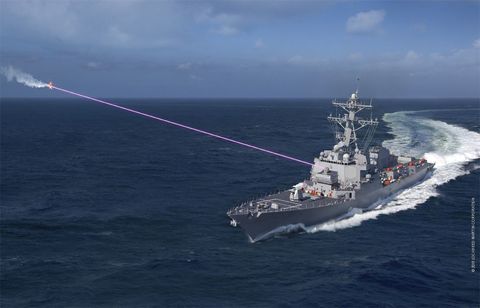The Navy Plans to Put HELIOS Laser Weapon on Destroyer by 2021
HELIOS will be capable of downing drones and “burning boats”.
By Kyle Mizokami LOCKHEED MARTIN
LOCKHEED MARTINPew-pew-pew is coming soon-soon-soon.
The U.S. Navy plans to put a laser weapon on a warship by 2021. The High Energy Laser with Integrated Optical-dazzler and Surveillance (HELIOS) system, or HELIOS, is a defensive weapon system designed to burn boats and shoot down unmanned drones. The weapon will go to sea with a guided missile destroyer assigned to the Pacific Fleet in two years' time, the Navy says.
The service placed an order for HELIOS in January 2019. The $150 million contract, awarded to Lockheed Martin, calls for the company to deliver two systems. According to a company press release, one will go to White Sands Missile Range in New Mexico for testing. USNI News says the Navy will install the other on a Arleigh Burke-class guided missile destroyer.
HELIOS is a 60-kilowatt laser system, meaning it has twice the power of the AN/SEQ-3 Laser Weapon System, or LaWS installed on the USS Ponce in 2014. HELIOS is billed as a weapon that can burn small speed boats of the type Iran deploys in armed swarms, and can torch unmanned aerial vehicles out of the sky. Alternately—and perhaps to avoid an international incident—HELIOS can simply “dazzle” a UAV’s electro-optical sensors, damaging them and preventing them from performing their mission.
HELIOS has a long-range intelligence, surveillance, and reconnaissance capability. While LockMart doesn’t spell out the details, we can surmise that the aiming system for the laser weapon/dazzle is probably capable of high-definition, high-powered digital magnification, allowing a ship fitted with it to closely watch nearby threats.
Many weapons already deployed on U.S. Navy warships, including the Phalanx close-in weapon system and the Rolling Airframe Missile (RAM), have a similar capability against small boats and drones as HELIOS while also being capable of taking on larger, faster aircraft and missiles. Range is also comparable.
Where a laser weapon like HELIOS shines, literally, is its ability to fire a theoretically unlimited number of shots using the destroyer’s onboard electrical generation systems. Phalanx, on the other hand, is limited to 20 to 30 seconds of continuous firing, while RAM is limited to 21 missiles aboard the Mk. 49 Guided Missile Launching System.
HELIOS is not a quantum leap above existing systems, but then again, early guns like the matchlock were in some ways inferior to the bow and arrow. Eventually, as firearms technology progressed, the gunpowder gun progressed to the point where it was clearly superior. As laser weapons become more powerful, they could quickly become much more effective than conventional gun and missile weapons.
No comments:
Post a Comment